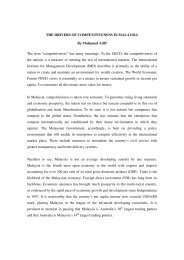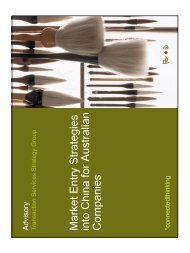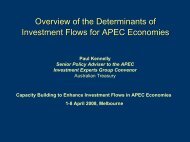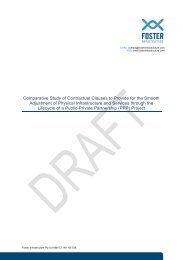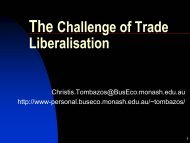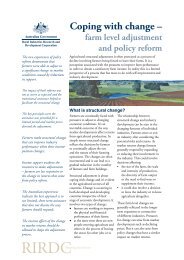australia-china free trade agreement conference brian pilbeam, pr
australia-china free trade agreement conference brian pilbeam, pr
australia-china free trade agreement conference brian pilbeam, pr
You also want an ePaper? Increase the reach of your titles
YUMPU automatically turns print PDFs into web optimized ePapers that Google loves.
8One reason why the investment environment in Chinese telecommunications is so challenging,is that China has no <strong>pr</strong>imary telecommunications legislation. However, this situation is soongoing to change: after many years of drafting, the new Chinese telecommunications law is in itsfinal stages and will come before the State Council very shortly.Reports on the draft law suggest that there is much that foreign investors will find encouraging.Unlike the current Services Classification Catalogue with its narrow inter<strong>pr</strong>etation of foreignparticipation in Value-Added and Basic Telecoms Services, we understand that the passage ofthe new telecoms law will greatly expand opportunities. It is particularly important that, coupledwith the new telecoms law, foreign investors should be accorded the full benefits of nationaltreatment within the scope of China's WTO commitments.The FTA offers the <strong>pr</strong>ospect of accelerating access and establishing a <strong>pr</strong>ocess for formaldialogue to sort out the issues I’ve detailed – <strong>pr</strong>ovided it contains particular reference totelecommunications.Firstly, Telstra is strongly committed to the view that the FTA should include a specificcomponent on telecommunications services to <strong>pr</strong>ovide for im<strong>pr</strong>oved market access. If in theend the FTA incorporates mechanisms to bring greater parity in the overall investmentopportunities available to each of our countries, this would strengthen Telstra’s position.Secondly, on the issue of regulation, we recognise there are significant differences betweenour regimes in terms of both industry regulation and competition policy. Australia has hadcompetition in the telecommunications area since the entry of Optus in 1992, while China’smarket opening <strong>pr</strong>ocess has only just begun.Telstra’s <strong>pr</strong>eferred option would be the development of a regulatory regime in China that islargely harmonised with conditions in Australia. The long term aim of a telecommunicationschapter in a FTA could be ex<strong>pr</strong>essed as a harmonisation of the two regulatory regimes, andthat their regulation should reflect international norms.It is Telstra’s understanding that China’s Ministry of Information Industry, or MII, holds thecurrent Australian model of telecommunications regulation in high regard. Therefore, Telstra




